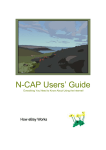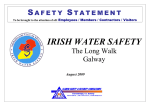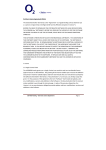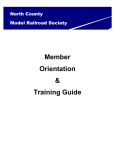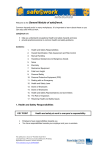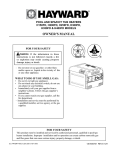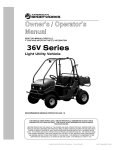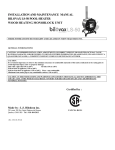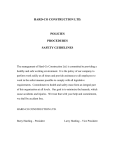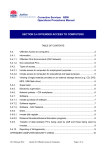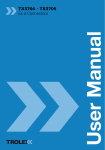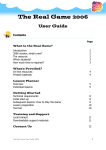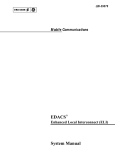Download Health & Safety Policy
Transcript
Safety Statement BeLonG To Youth Service Parliament House 13 Parliament Street Dublin 2 September 2014 Version 1.0 1 BeLonG To Youth Service Safety Team as at 2nd September 2014 Safety Officer(s): David Carroll Oisín O' Reilly Fire Warden(s): Oisín O' Reilly John Duffy First Aider(s): John Duffy Gerard Roe 2 CONTENTS Part 1: Safety Policy Statement Part 2: Organisational Responsibilities Part 3: Preparations and Procedures for Safety, Health and Welfare Part 4: Fire Evacuation Procedures 3 Safety Policy Statement It is the policy of BeLonG To Youth Service to comply with the terms of the Safety, Health and Welfare Acts 2005 and subsequent legislation and to provide and maintain a healthy and safe working environment. BeLonG To Youth Service health and safety objective is to minimise the number of instances of occupational accidents and illnesses and ultimately to achieve an accident-free workplace. All employees will be provided with such equipment, information, training and supervision as is necessary to implement the policy and achieve the stated objective. The management of BeLonG To Youth Service recognise and accept their duty to protect the health and safety of all visitors to the premises, including contractors and temporary workers, as well as any members of the public who might be affected by their work. While the management of BeLonG To Youth Service will do all that is within their power to ensure the health and safety of its employees, it is recognised that health and safety at work is the responsibility of each and every individual associated with the office. It is the duty of each employee to take reasonable care of their own and other people’s welfare and to report any situation which may pose a threat to the well being of any other person. The management of BeLonG To Youth Service will provide every employee with the training necessary to carry out their tasks safely. However, if an employee is unsure how to perform a certain task or feels it would be dangerous to perform a specific job, then it is the employee’s duty to report this to their immediate supervisor or the Safety Officer. An effective health and safety programme requires continuous communication between employees at all levels. It is therefore every employee’s responsibility to report immediately any situation which could jeopardise the well being of themselves or any other person. All injuries, however small, sustained by a person a work, must be reported to the Safety Officer or a delegated representative. Accident records are crucial to the effective monitoring and revision of the policy and must therefore be accurate and comprehensive. BeLonG To Youth Service health and safety policy will be continually monitored and updated, particularly if changes in the scale and nature of their operations occur. The specific arrangements for the implementation of the policy and the personnel responsible are detailed within the safety statement folder which is kept on the premises at all times. Signed: Anna Quigley - Chairperson Board of Directors Date: 2nd September 2014 4 PART 2: ORGANISATIONAL RESPONSIBILITIES 1. Employer Statutory Duties 2. Employee Statutory Duties 3. Senior Management Responsibilities 4. Safety Officer Responsibilities 5. Safety Representative Rights 6. Fire Wardens Responsibilities 5 ORGANISATIONAL RESPONSIBILITIES Section 8 of the Safety, Health and Welfare at Work Act 2005 1. Employer Statutory Duties Every employer shall ensure, so far as is reasonably practicable, the safety, health and welfare at work of his or her employees. Every employer shall manage and conduct work activities in such a way as to ensure, so far as is reasonably practicable, the safety, health and welfare at work of his or her employees. Every employer shall prevent, so far as is reasonably practicable, any improper conduct or behaviour. Every employer shall provide and maintain a safe means of access to and egress from the workplace. Every employer shall provide and maintain safe plant and machinery or any other articles that are safe and without risk to health. Every employer shall ensure, so far as it is reasonably practicable, the safety and the prevention of risk to health at work of his or her employees relating to the use of any article or substance or the exposure to noise, vibration or ionising or other radiations or any other physical agent. Every employer shall provide systems of work that are planned, organised, performed, maintained and revised as appropriate so as to be, so far as is reasonably practicable, safe and without risk to health. Every employer shall provide and maintain facilities and arrangements for the welfare of his or her employees at work. Every employer shall provide the information, instruction, training and supervision necessary to ensure, so far as is reasonably practicable, the safety, health and welfare at work of his or her employees. Every employer shall determine and implement the safety, health and welfare measures necessary for the protection of the safety, health and welfare of his or her employees when identifying hazards and carrying out a risk assessment. Every employer shall provide and maintain suitable protective clothing and equipment as is necessary to ensure, so far as is reasonably practicable, the safety, health and welfare at work of his or her employees. Every employer shall prepare and review, adequate plans and procedures to be followed and measures to be taken in the case of an emergency or serious and imminent danger. Every employer shall report accidents and dangerous occurrences, to the H.S.A. Every employer shall obtain, where necessary, the services of a competent person for the purpose of ensuring, so far as is reasonably practicable, the safety, health and welfare at work of his or her employees. 2. Employee Statutory Duties Section 13 of the Safety, Health and Welfare at Work Act 2005 An employee shall, while at work: Take reasonable care to protect his or her safety, and the safety of any other person who may be affected by the employee’s acts or omissions at work. Ensure that he or she is not under the influence of an intoxicant to the extent that he or she is in such a state as to endanger his or her own safety, health or welfare at work. 6 If reasonably required by his or her employer, submit to any appropriate, reasonable and proportionate tests for intoxicants by, or under the supervision of, a registered medical practitioner who is a competent person, as may be prescribed. Co-operate with his or her employer or any other person so far as is necessary to enable his or her employer to comply with the relevant statutory provisions, as appropriate. Not engage in improper conduct or other behaviour that is likely to endanger his or her own safety, health and welfare at work. Attend such training and, as appropriate, undergo such assessment as may reasonably be required by his or her employer relating to safety, health and welfare at work or relating to the work carried out by the employee. Having regard to his or her training and the instructions given by his or her employer, make correct use of any article or substance provided for use by the employee at work or for the protection of his or her safety, health and welfare at work, including protective clothing or equipment. Report to his or her employer any defect in the place of work, which might endanger the safety, health or welfare at work of the employee or that of any other person. 3. Senior Management Responsibilities Act as chair of the safety committee, where one exists. Advance the aims and objectives of health and safety at work throughout the organisation. Provide both the human and financial resources necessary to implement the organisations safety policy. Report to the board on: overall health and safety status; periodically report on accidents, statistics. Detail any statutory enforcement orders issued that may apply. Inform of impending health and safety legislation that is likely to affect the organisation. Propose updates to the safety statement for ratification by the board where appropriate. 4. Safety Officer Responsibilities Ensure that employees are properly trained and instructed as to their statutory duties and responsibilities. Make recommendations for improving performance. Allocating the necessary resources within their control. Ensuring that accidents and near-misses are recorded and investigated. Monitoring of contractors. Ensuring that company safety policies and procedures are distributed to all staff. Ensuring that appropriate equipment is available. Ensuring that equipment is maintained in a safe condition. Ensuring that first aiders are trained and that cover is provided. Monitoring the implementation of the policy. Understanding company procedures and policies. Maintaining relevant documentation relating to health and safety at work. Carrying out audits of their place of areas of responsibility and undertaking workplace inspections. 7 5. Safety Representative Rights Section 25 of the Safety, Health and Welfare at Work Act 2005 A safety representative may: Inspect the whole or any part of the place of work. Investigate accidents and dangerous occurrences provided that he or she does not interfere with or obstruct the performance of any statutory obligation. After the giving of reasonable notice to the employer, investigate complaints relating to safety, health and welfare at work made by any employee whom he or she represents. Accompany an inspector who is carrying out an inspection of the place of work, other than an inspection for the purpose of investigating an accident or dangerous occurrence, at the discretion of the inspector concerned. Accompany an inspector who is carrying out an inspection for the purpose of investigating an accident or dangerous occurrence, at the discretion of the inspector concerned. Where an employee is interviewed by an inspector with respect to an accident or dangerous occurrence at a place of work, attend the interview where the employee so requests. Make representations to the employer on any matter relating to safety, health and welfare at the place of work. Make oral or written representations to inspectors on matters relating to safety, health and welfare at the place of work, including the investigation of accidents or dangerous occurrences. 6. Fire Wardens Responsibilities Ensure that fire prevention is continually brought to the attention of all employees. Ensure that evacuation routes and exit doors are always kept clear of obstruction. Ensure that staff are aware of their responsibilities during a fire, and are aware of the location of emergency exits and assembly points. Periodically check fire extinguishers to ensure that their location hasn’t changed and that they are fully operational. Arrange at least two fire drills each year in consultation with management. During an evacuation, ensure the evacuation of all staff within their area of responsibility, without putting themselves at risk or any danger. Carry out a roll call at the assembly point after a fire or fire drill. Liaise with the fire service. 8 PART 3: PREPARATIONS AND PROCEDURES FOR SAFETY, HEALTH AND WELFARE 1. General Resources for Health and Safety 2. Fire Safety 3. Electrical Safety 4. First Aid 5. Consultation 6. Training 7. Housekeeping 8. Revision and Monitoring 9. Manual Handling 10. Other Persons on Company Premises 11. Accident Reporting and Investigation 12. Bullying and Harassment Policy 13. Smoke Free Workplace Policy 14. Display Screen Equipment 15. Contractors 16. Control of Substances Hazardous to Health 17. Risk Assessments 18. Alcohol and Drugs Policy 19. Workplace Safety Guidelines 9 1. General Resources for Health and Safety To secure the safety, health and welfare of employees, BeLonG To Youth Service dedicate all resources that are deemed necessary to secure the health and safety of all employees. These include courses, seminars or in-house training for employees who are at risk from identified hazards. BeLonG To Youth Service commits itself to dedicate at all times the financial resources necessary to ensure as far as is reasonably practicable the safety, health and welfare of its employees. 2. Fire Safety We will provide the necessary fire fighting equipment in accordance with the requirements of the Fire Services Act 2003. It is the policy of BeLonG To Youth Service to over rather than under provide such facilities. All employees are required to familiarise themselves with the fire drill before commencing work. Drills will be arranged at regular intervals, ideally two per year. Existing fire fighting equipment will be inspected by the Safety Officer on a weekly basis and by the external contract engineers on an annual basis. Alarms will be tested weekly. Fire exits must be kept clear at all times. No fire door to or from an occupied room may be locked. Smoking is not permitted anywhere within the organisations premises. No doors are to be wedged or propped open in any way. All personnel will be trained in the safe use of fire fighting equipment. Employees should know which extinguishers are available in their immediate place of work. In particular, employees should ensure that combustible materials do not accumulate around their place of work. Flammable materials must never be exposed to hot surfaces or direct heat sources. In the event of a gas leak switch off all equipment and evacuate the premises immediately. Contact the Emergency Services immediately. In the event of a fire the premises should be evacuated immediately following the information provided on the fire notices/fire procedures. Fire extinguishers should only be removed from their wall brackets in an emergency. The removal of fire extinguishers in other cases without good reason will be considered as misconduct. 3. Electrical Safety Ensure that all electrical equipment you use is in good order. Do not use any electrical equipment that does not appear to be in good order but report it to your supervisor without delay. Changes to the electrical system (including new plugs) should only be undertaken by competent persons who have been trained and all works required should be reported to the Safety Officer. 10 Work on 3 phase electrical systems or live plant must never be undertaken by unqualified personnel and live working requires a specific risk assessment to be undertaken. General Safety Requirements for Electrical Systems: Switch off all electrical equipment after use. Do not overload sockets. Do not allow wires to project into the walkways where they present a tripping hazard. Use a residual circuit breaker when operating a portable hand tool. 4. First Aid BeLonG To Youth Service will provide first aid provisions in accordance with the requirements under the Safety, Health and Welfare at Work Act 2005 and the General Application Regulations. The nominated first aiders will be published on the notice board. If you suffer an injury, however slight, report it to your supervisor and the nominated first aider at once. The injury must be entered in the accident report book and you will be required to provide a full explanation of the events surrounding the accident. If a serious accident occurs the first aider should be contacted at once. The first aider will arrange for an ambulance to be summoned immediately. If chemicals come into contact with your skin or eyes or if they are swallowed or inhaled then seek immediate first aid. Your supervisor will have access to the chemical data sheets which provide detailed advice on the measures to be taken to counteract the effects of each chemical used by the company. 5. Consultation Reference: Section 13 of the Safety, Health and Welfare at Work Act 2005 Company employees can make representation to their General Manager on safety issues. They will consider the representations and act on them as necessary. Safety Officers and other departmental managers and overseers are all part of the consultation process. 6. Training General induction training will be provided for all new members of staff. Additional training will be provided for nominated members of staff as required. The planning of training in health and safety is the responsibility of the Safety Officer. Documented training records will be maintained. If any member of staff feels that he/she could benefit from specific safety training in addition that that which has been assessed as relevant by the organisation then they should approach their supervisor. 7. Housekeeping Good housekeeping in all areas is an essential feature of safety and the prevention of accidents. Staff working in all areas must have regard to the following: 11 Ensure that loose and worn flooring is reported to your supervisor. Ensure all entrances, corridors, walkways and exit doors are kept clear of obstructions at all times. Close all cabinets, cupboards and drawers after use. Never overload shelving or store heavy items above head height except on load bearing purpose building racking. Clear away immediately any dangerous substance or spillage. Dangerous substances are marked and are defined as toxic, harmful, irritant, flammable or oxidising. Dust and fumes should not be inhaled. If dust or fumes are produced by any activity then cease the task immediately until protective measures have been put into place. Equipment must not be left where it can be a tripping hazard. 8. Revision and Monitoring Reference: Section 20 of the Safety, Health and Welfare at Work Act 2005 The Safety Statement will be reviewed on a yearly basis and will be changed by the Safety Officer as names of responsible persons change, hazards and risks change or changes in legislation occur. The Safety Statement will be monitored by having the relevant Safety Officer carry out regular inspections of the organisation processes and premises; evaluate all accidents and dangerous occurrences. 9. Manual Handling Lifting and moving loads by hand is the biggest cause of injury in the work place. Lifting should be carried out in accordance with the following guidelines: If a load is awkward or beyond your capability you must get help. Check all packaging and articles for sharp edges and projections before lifting. Ensure that there are no obstructions in your path before lifting any article. Ensure that you can see around a load when lifting it. Ensure that there is adequate room to put down a load when you have moved it. When lifting stand close to the load with your feet slightly apart. Keep your chin in, bend your knees and keep your back straight at all times. Straighten your knees using your thigh muscles. Always lift in stages (e.g. floor to knee, knee to carrying position). Always use your entire body weight in a controlled manner when pushing a load. Heavy goods are to be lifted in accordance with the organisation assessments for manual handling. Do not use lifting equipment unless you have been specifically authorised. 10. Other Persons on Company Premises Other people on company premises are bound by the following rules: They are obliged to observe the safety rules and any instructions given by company staff which enforce the company’s Safety Statement. They should not work on the premises unless covered by insurance against risk. All contractors insurance policies should be examined to ensure they conform to legal requirements. Contractors safety statements 12 should be made available to the relevant manager. They should not enter areas they are not authorised to visit. 11. Accident Reporting and Investigation While staff have an obligation to report all accidents, (near misses) incidents, the Safety Officer has an extra responsibility to ensure that an accident report form is completed and that an investigation is carried out. An investigation will be carried out to record what happened and from this, to decide what action will be taken to prevent recurrence. The Accident Report is compiled by the person in charge of the area as soon as possible following the accident. A sample accident report form is to be found in the appendices. The decision whether to have a more in-depth investigation will be taken by the Safety Officer. The Safety Officer will ensure that reports are completed as necessary to the following: The General Manager/appropriate Senior Manager; Insurance Company; Health and Safety Authority. In case of fatality the following outside bodies are notified: The General Manager/appropriate Senior Manager; The Garda; Insurance Company; Health and Safety Authority. All notifiable accidents and dangerous occurrences must be reported to the Health and Safety Authority on the approved forms. 12. Bullying and Harassment Policy Fundamental to the concept of equality and respect for others in the working environment, employees should be free from any activity or behaviour that adversely affects the dignity of people in the workplace. Bullying can be defined as repeated aggression, verbal, psychological or physical, conducted by an individual or group against others. Isolated incidents of aggressive behaviour while not be to tolerated, should not be described as bullying. Only inappropriate aggressive behaviour which is systematic and ongoing is regarded as bullying. It is the intention of BeLonG To Youth Service to ensure that the working environment provides all employees the freedom to conduct their work without having to endure bullying and intimidation. All employees should be aware that bullying which affects the dignity of people at work, undermines them as human beings and is totally unacceptable to the company. Bullying and intimidation can be grounds for disciplinary action, including dismissal for serious offences. In order to deal with incidents of this nature as effectively as possible, staff experiencing harassment should report the matter to their immediate supervisor. For further information, please see staff handbook. 13 13. Smoke Free Workplace Policy It is the policy of BeLonG To Youth Service that the entire workplace area is smoke-free and that all employees have a right to work in a smoke-free workplace. Smoking is prohibited throughout the workplace with no exceptions. This policy applied to all employees, consultants, contractors, customers, service users and visitors. 14. Display Screen Equipment It is the policy of BeLonG To Youth Service to comply with the law as set out in the Safety, Health and Welfare at Work (General Applications), (Chapter 5 of Part 2: Display Screen Equipment), Regulations 2007. We will conduct health and safety assessment of all workstations staffed by employees who use VDU screens as part of their usual work and will ensure that all workstations meet the requirements of the regulations. All VDU screen users will be given appropriate and adequate training on the health and safety aspects of this type of work and will be given further training and information whenever the organisation of the workstation is substantially modified. Employer Duties Employees: are entitled to have their workstation assessed in line with the requirements of the regulations. must be trained in the use of the workstation and be given information about health and safety factors. must have periodic breaks or changes of routine away from VDUs. must be informed by their employer that they are entitled to an appropriate eye and eyesight test (or may opt for either) before working with VDUs and at regular intervals. are entitled to an appropriate eye and eyesight test (or may opt for either) before working with VDUs and at regular intervals. If at any time working with VDUs an employee experiences visual difficulties he or she has a similar entitlement. 15. Contractors Contractors must be familiar with and conform to our Safety Policy. Contractors must produce evidence when requested that appropriate employer liability and public liability insurance is in place. Contractors must bring to the attention of the General Manager or Safety Officer any process or use of materials which may be a danger to safety and health. Contractors must report defect in plant or equipment without delay. Contractors must ensure adequate information and training is provided for employees, submit certificates of test and thorough examination for lifting appliances brought onto the premises, and conform generally with the responsibilities of employees. 16. Control of Substances Hazardous to Health The law requires the organisation to control the use, disposal and transportation of all hazardous materials. A formal assessment has been carried out of all materials used by the company and this is available on site at all times for reference purposes. Employees are not permitted to purchase or to bring to work substances which are not included on 14 the chemical safety register. If a formal assessment has not been made then that product may not be brought onto site. Disposal of chemical products must only be carried out on the direct instruction of the Safety Officer. It is a strict requirement of the organisation that when any person handles a chemical they never mix it with any other chemical product. The mixing of chemicals can lead to harmful chemicals being formed inadvertently. Working safely with cleaning agents. The four ways in which chemicals can enter the body: Inhalation: Breathing in contaminated air is the most common way that workplace chemicals enter the body. Contact with the skin or eyes: Some chemicals can damage the skin or eyes (e.g. irritation) or pass through the skin into the body. Ingestion: Workplace chemicals may be swallowed accidentally if food or hands are contaminated. Injection: Injection can occur when a sharp object (e.g. needle) punctures the skin and injects a chemical directly into the bloodstream. 17. Risk Assessments Risk assessments have been completed to identify the fundamental risks involved in the business operations of BeLonG To Youth Service. The assessments look at the hazards of the operations set against the real risks to employees, contractors, visitors and third parties who come into contact with the business. Statutory Requirements The assessment of the risks involved in the operation of BeLonG To Youth Service must have due regard for the statutory requirements for health and safety at work. Associated Documentation These risk assessments must be read in conjunction with documentation intended to ensure safe systems of work and safe practices in the workplace. Reference should be made to the following documents produced or held by BeLonG To Youth Service: Company Safety Policy Company Work Instructions Company Training Records Company Fire Log Public Liability and Employers Liability Insurance Certificates Company Accident Records Pregnancy During pregnancy personnel may be at increased risk in certain situations. Pregnancy may affect an employee’s ability to handle goods or stand for prolonged periods of time, resulting in a safety issue. Hard and fast rules for pregnancy are difficult to put in place as cases vary and some staff may take exception to being restricted at work when pregnant and staff may be pregnant without the organisation being aware. When a member of staff is pregnant they should not be required to lift or carry anything other than very light weights unless they have documentary agreement from the Medical 15 Practitioner to state that they can lift heavier items. Where a pregnant employee has to work in the standing position a facility should be provided for that member of staff to take regular breaks to sit down. The number of breaks should be determined between the employee and her supervisor. There is no evidence to suggest that work with visual display screens is harmful to pregnant mothers and there is no known reason to restrict this work. In the event of any pregnant employee suffering from any illness or discomfort in the workplace she should be referred immediately to her Medical Practitioner. In the event of any concerns over the work which the pregnant employee is involved with, advice should be sought from the Medical Practitioner. Personal protective equipment must be kept under review throughout the period when the pregnant employee is at work. Company Risk Assessments It is the policy of BeLonG To Youth Service to encourage all staff and third parties to work together to create a healthy and safe working environment. To fulfil this policy hazards have to be identified and suitable steps taken to prevent injury or ill health to BeLonG To Youth Service staff, or third parties, who may include contractors or visitors. This procedure is intended to provide guidance for those members of staff with specific responsibility for assessing and controlling risks within their areas of responsibility, complementing the responsibilities detailed in the general Safety Policy Statement. It is important to note this procedure relates to the long-term health of individuals as well as the management of the safety of such individuals, which focuses on the prevention of injuries. Risks to health, such as occupational stress or infectious diseases must be considered as well as the more obvious safety illnesses, such as those which relate to manual handling or fire evacuation. What is a Risk Assessment? A risk assessment is the systematic identification of potential hazards in the workplace by personnel as a first step to controlling the possible risks involved. A hazard is anything that has the potential to cause harm. A risk is the likelihood of someone being exposed to that hazard and harmed as a result. Risk assessments must be in place for all BeLonG To Youth Service operations. The risk assessment should assess the risk that may be present in all work activities, and may identify particular areas for more detailed ‘specific’ assessments. A duty of care is owed to the individual, and risk assessments must take this into account. Therefore, a person with special needs (such as people with physical or learning difficulties, young persons and pregnant women) will require an assessment of their activities which take their special needs into account. Why are Risk Assessments necessary? Risk assessments are important for two main reasons: 1. The process is a fundamental part of national law. 2. It manages potential dangers in the workplace. It is important to remember that it may not be possible to eradicate problems completely. Always remember the phrase “reasonably practicable”. 16 Who should carry out Risk Assessments? Essentially, individuals who are familiar with the working area and working practices should be involved with the risk assessment process. The Safety Officer (Risk Assessor) is responsible for developing a risk assessment plan and completing assessments in accordance with this plan. This should be done in consultation with supervisor for their areas of responsibility. The management of BeLonG To Youth Service have ultimate responsibility to ensure that risk assessments are completed. When should Risk Assessments be completed? Risk assessments should be completed at least once a year provided that no changes have occurred during this time. If either the working environment or working practices are amended, however slightly, a new risk assessment must be performed. Risk assessments should also be carried out if any new procedures relevant to the safety health and welfare of employees are being introduced. How do you perform a Risk Assessment? There are five steps to performing a satisfactory risk assessment: 1. 2. 3. 4. 5. Identify hazards Identify who is at risk Evaluate the risk Establish control measures Record decisions and review regularly Administration The Risk Assessor should retain completed Risk Assessment Forms and a copy must be held on site. Risk assessments must be made available to all relevant personnel and they must be kept up to date. 18. Alcohol and Drugs Policy BeLonG To Youth Service is aware of its responsibilities to provide, as far as is reasonably practicable, a safe and healthy working environment, and recognises that this can be put at risk by those who misuse alcohol or drugs to such an extent that it may affect their health, performance, conduct, and safety, or the safety of others whilst in the workplace. All employees, regardless of status, are expected to adhere to, and observe, current and future legislation, and both BeLonG To Youth Service and client policies and rules regarding the consumption of alcohol and/or drugs whilst on, or reporting for, duty or whilst on company or client premises. The consumption of alcohol on BeLonG To Youth Service premises is not allowed except at authorised company functions or with the prior consent of senior management. Any employees, regardless of status, found consuming either drugs or unauthorised alcohol on company premises, or thought unfit to carry out their normal duties through the unauthorised consumption of such, may be subject to disciplinary action. 17 BeLonG To Youth Service reserves the right to remove from site and suspend from work any employee suspected to be in breach of this policy through misuse of alcohol or drugs, pending further investigation. Any employee found to be in breach of legislation and/or either company or client policy or rules may be subject to disciplinary action for gross misconduct which may lead to summary dismissal. BeLonG To Youth Service would prefer to help staff who might have a problem, not penalise them. Staff who seek help and declare a belief that they have a problem concerning either alcohol or drugs will be dealt with sympathetically by the company and support will be given where possible. 19. Workplace Safety Guidelines General Guidelines All employees should be aware of, respect and adhere to the rules and procedures contained in this policy statement. All employees shall immediately report any unsafe practices or conditions to the relevant authority. Any person under the influence of alcohol or any other intoxicating drug which might impair motor skills or judgement, whether prescribed or otherwise, shall not be allowed on the job. Horseplay, practical joking or any other acts which might jeopardise the health and safety of any other person are forbidden. Any person whose levels of alertness and/or ability are reduced due to illness or fatigue will not be allowed on the job if this might jeopardise the health and safety of that person or any other person. Employees shall not adjust, move or otherwise tamper with any electrical equipment, machinery or air or water lines in a manger not within the scope of their duties, unless instructed to do so by a senior member of staff. All waste materials must be disposed of carefully and in such a way that they do not constitute a hazard to other workers. No worker should undertake a job which appears to be unsafe. No worker should undertake a job until he or she has received adequate safety instruction and is authorised to carry out the task. All injuries must be reported to the Safety Officer or a delegated representative. Employees should take care to ensure that all protective guards and other safety devices are properly fitted and in good working order and shall immediately report any deficiencies to the supervisor or Safety Officer. Work shall be well planned and supervised to avoid injuries in the handling of heavy materials and while using equipment. No employees should use chemicals without the knowledge required to work with those chemicals safely. Suitable clothing and footwear will be work at all times. Personal protective equipment shall be worn wherever appropriate. All employees are expected to attend departmental safety meetings. Working Environment Work sites must be kept clean and tidy. Any spillage must be cleaned up immediately. Waste materials and rubbish must be removed routinely. All combustible waste materials must be discarded in sealed metal containers. 18 All pits and holes must be covered when not in use and clearly marked with warning signs when in use. Walkways Walkways and passageways must be kept clear from obstructions at all times.# If a walkway or passageway becomes wet it should be clearly marked with warning signs and/or covered with non-slip material. Trailing cables are a trip hazard and should not be left in any passageway. Any change in the floor elevation of any walkway or passageway must be clearly marked. Where objects are stored in or around a passageway, care must be taken to ensure that no long or sharp edges jut out into the passageway in such a way as to constitute a safety hazard. Where a passageway is being used by any vehicles or other moving machinery an alternative route should be used by pedestrians wherever possible. If no alternative route is possible the areas should be clearly marked with warning signs. Personal Protective Equipment (PPE) Employees must use all personal protective equipment provided to them in accordance with the training and instruction given to them regarding its use. Employees who have been provided with personal protective equipment must immediately report any loss of or obvious defect in any equipment provided to their supervisor or the Safety Officer. Tools and Equipment Company machinery and tools are only to be used by qualified and authorised personnel. It is the responsibility of the supervisor to determine who is authorised to use specific tools and equipment. It is the responsibility of all employees to ensure that any tools or equipment they use are in a good and safe condition. Any tools or equipment which are in any way defective must be repaired or replaced. All tools must be properly and safely stored when not in use. No tool should be used without the manufacturers recommended shields, guards or attachments. Approved personal protective equipment must be properly used where appropriate. Persons using machine tools must not wear clothing, jewellery or long hair in such a way as might pose a risk to their or anyone elses safety. Employees are prohibited from using any tool or piece of equipment for any purpose other than its intended purpose. Manual Lifting and Moving Lifting and moving of objects should always be done by mechanical devices rather than manual handling wherever reasonably practicable. The equipment used should be appropriate for the task at hand. The load to be lifted or moved must be inspected for sharp edges, slivers and wet or greasy patches. When lifting or moving a load with sharp or splintered edges gloves must be worn. Gloves should be free from oil, grease or other agents which might impair grip. The route over which the load is to be lifted or moved should be inspected to ensure that it is free of obstructions or spillage which could cause tripping or spillage. Employees should not attempt to lift or move a load which is too heavy to manage comfortably. 19 If team lifting or moving is necessary, one person should act as co-ordinator, giving commands to lift, lower, etc. When lifting an object off the ground, employees should assume a squatting position, keeping the back straight. The load should be lifted by straightening the knees, not the back. These steps should be reversed for lowering an object to the ground. High Voltage and Low Voltage Electricity Don’t work alone – in the event of an emergency another person’s presence may be essential. Always keep one hand in your pocket when anywhere around a powered lineconnected or high voltage system. Wear rubber bottom shoes. Wear eye protection – large plastic lensed eyeglasses or safety goggles. Don’t wear any jewellery or other articles that could accidentally contact circuitry and conduct current, or get caught in moving parts. Set up your work area away from possible grounds that you may accidentally contact. Know your equipment: TVs and monitors may use parts of the metal chassis as ground return yet the chassis may be electrically live with respect to the earth ground of the AC line. Microwave ovens use the chassis as ground return for the high voltage. In addition, do not assume that the chassis is a suitable ground for your test equipment! If circuit boards need to be removed from their mountings, put insulating material between the boards and anything they may short to. Hold them in place with string or electrical tape. Prop them up with insulation sticks – plastic or wood. Connect/disconnect any test leads with the equipment unpowered and unplugged. Use clip leads or solder temporary wires to reach cramped locations or difficult to access locations. Perform as many tests as possible with power off and the equipment unplugged. For example, the semiconductors in the power supply section of a TV or monitor can be tested for short circuits with an ohmmeter. When handling static sensitive components, an anti-static wrist strap is recommended. However, it should be constructed of high resistance materials with a high resistance path between you and the chassis (greater than 100K ohms). Never use metallic conductors as you would then become an excellent path to ground for line current. Don’t attempt repair work when you are tired. Not only could you be more careless, but your primary diagnostic tool – deductive reasoning – will not be operating at full capacity. Finally, never assume anything without checking it out for yourself. Don’t take shortcuts! Portable Ladders Do not hand-carry loads on a ladder. Do not try reaching so far that you lose your balance; move the ladder. Non-skid feet or spurs may prevent a ladder from slipping on a hard, smooth surface. Do not stand on the ladder’s top three rungs. A damaged side rail may cause one side of a ladder to give way. The base should be spaced one foot away for every four feet it reaches up. Ladders used to reach a walking surface or roof must extend at least three feet beyond. Extension ladders need both locks holding to prevent overloading a rail. Step ladders should be securely spread open. Never use a folding step ladder in an unfolded position. 20 Electrical shock can occur with metal or wet wooden ladders. Not only is the shock itself dangerous, but it can cause falls resulting in injury. Portable Hand Tools Never carry a tool by the cord or hose. Never yank the cord or the hose to disconnect it from the receptacle. Keep cords and hoses away from heat, oil and sharp edges. Disconnect tools when not using them, before servicing and cleaning them, and when changing accessories such as blades, bits, and cutters. Keep all people not involved with the work at a safe distance from the work area. Secure work with clamps or a vise, freeing both hands to operate the tool. Avoid accidental starting. Do no hold fingers on the switch button while carrying a plugged-in tool. Maintain tools with care; keep them sharp and clean for best performance. Follow instructions in the user’s manual for lubricating and changing accessories. Be sure to keep good footing and maintain good balance when operating power tools. Wear proper apparel for the task. Loose clothing, ties, or jewellery can become caught in moving parts. Remove all damaged portable electric tools from use and tag them: “Do Not Use”. 21 PART 4: Emergency Evacuation Procedures Emergency refers to any event that may require an evacuation of the premises (e.g. gas leak, fire, bomb threat etc.) The person who becomes or is made aware of a potential emergency should first sound the alarm. On hearing the alarm, all employees and visitors must: Go immediately to the emergency exits, closing all doors as they leave. Not wait to find out what is happening. Not stop to collect personal items. Go at once to their assembly point and wait for further instruction. Not re-enter the building until authorised to do so by emergency services. Fire Detection & Warning signs Carry out periodic fire drills and check that fire detection warning systems are working correctly. Ensure that fire safety detection/warning systems are serviced and maintained by a competent person. 22 PART 5: APPENDICES Appendix 1: Workplace Health and Safety Audit Checklist Appendix 2: Workstation Audit Checklist Appendix 3: Safety Statement Annual Audit Checklist Appendix 4: Employee Statement Appendix 5: Accident Report Form Appendix 6: Employee Safety Induction Training Form 23 Appendix 1: Workplace Health & Safety Audit Checklist Please see risk assessment templates 1 - 24 available from the safety officer(s). 1. First Aid 2. Canteen General Considerations 3. Cleaning General Considerations 4. Clean Hazardous Substances 5. Cleaning Toilets and Showers 6. Slips Trips and Falls 7. General Access and Egress 8. Fire General Rooms and Offices 9. Fire Events 10. Portable Electronic Devices 11. Bullying 12. Staff Offices 13. Noise 14. Pregnant Post-Natal and Breastfeeding Women 15. Radon 16. Mould 17. Asbestos 18. Legionella 19. Lone Workers 20. Work Placements 21. Outdoor Adventure Activity 22. Computers 23. Day Trips 24. Young Person Considerations 24 Appendix 2: Workstation Audit Checklist Workstation: _________________________ Date: Auditor: _________________________ _________________________ Y Are the characters clear? Is the image size adequate? Is the image flicker free? Are the brightness and contrast adjuster working? Is the keyboard design adequate? Are the characters on the keys clear? Is there reasonable space at the workstation? Is the lighting in the room adequate? Is there provision to ensure that background light does not cause difficulty for the user viewing the screen? Is electromagnetic radiation reduced to acceptable levels? Does the screen swivel and tilt easily? Can the screen be separated from the base? Can the keyboard be tilted? Is the keyboard separate from the screen? Can arms and hands be rested on the desk in front of the keyboard? Is the desk or work surface large enough to allow flexible arrangements for the equipment? Is the document holder stable and adjustable? Is there adequate space at the workstation to allow the use to find a comfortable position? N Y N Is the work chair stable and movable? Can the seat height and the seat back be adjusted? Has a footrest been made available? Are windows provided with suitable blinds? Are noise, heat and humidity at acceptable levels? Have employees been made aware of quantitative and qualitative checking facilities used in software systems? Does the system provide feedback to employees on their performance? Does the user feel that he/she has had sufficient training in the use of the system software? Does the user feel that he/she has had sufficient training on the use of the workstation equipment? Does the user feel that he/she has adequate breaks away from the VDU? Has the user been made aware of the guidelines for safety at VDU equipment? Has the user had a suitable eye test for VDU work? Does the user find any problems in his/her VDU work? If yes, please elaborate. Auditors Signature: __________________________ Date of next scheduled audit: __________________________ 25 Appendix 3: Safety Statement Annual Audit Checklist Date: _________________________ Auditor: _________________________ Y/N Details Remedial Action Required, by whom and by when Has the Safety Statement been reviewed in the last 12 months? If the Safety Statement has been updated in the last 12 months, has it been ratified by the Board of Directors, signed by the Director, and circulated to all staff? Are the Safety Team roles filled and members trained? If any new employees have commenced employment in the last 12 months, have they been inducted in the organisations safety statement, policies and procedures? Have two fire evacuation drills been carried out in the last 12 months? Has a workplace health and safety audit been completed every six months? Has a workstation audit been completed on each workstation at least once in the last 12 months? Have all staff been informed of their entitlement to an eye and eyesight test? 26 Appendix 4: Employee Statement I hereby acknowledge receipt of a copy of the BeLonG To Youth Service Safety Statement and agree to follow the advice and procedures contained therein. Employee Name Signature Date 27 Appendix 5: Accident Report Form An incident report book is in place and held by the safety officer(s) at a minimum the information below should be included in the safety book. Date: ______________________________ Reported by: ________________________ Location: _______________________ Signature: _______________________ Name Injuries Sustained Action Taken Description of Incident/Accident: _____________________________________________________________________ _____________________________________________________________________ _____________________________________________________________________ _____________________________________________________________________ _____________________________________________________________________ _____________________________________________________________________ Give details of any actions already take to prevent a recurrence: Actions Taken: _____________________________________________________________________ _____________________________________________________________________ _____________________________________________________________________ Actions Required: _____________________________________________________________________ _____________________________________________________________________ _____________________________________________________________________ 28 Appendix 6: Employee Safety Induction Training Form Employees Name: Training Provided Job Title: Date Start Date: Employee Signature Trainer Signature Safety Induction Manual Handling Fire Evacuation Procedures 29






























